new posts in all blogs
Viewing: Blog Posts Tagged with: Art Schools, Most Recent at Top [Help]
Results 1 - 13 of 13
How to use this Page
You are viewing the most recent posts tagged with the words: Art Schools in the JacketFlap blog reader. What is a tag? Think of a tag as a keyword or category label. Tags can both help you find posts on JacketFlap.com as well as provide an easy way for you to "remember" and classify posts for later recall. Try adding a tag yourself by clicking "Add a tag" below a post's header. Scroll down through the list of Recent Posts in the left column and click on a post title that sounds interesting. You can view all posts from a specific blog by clicking the Blog name in the right column, or you can click a 'More Posts from this Blog' link in any individual post.

By: Kirsty,
on 10/28/2010
Blog:
OUPblog
(
Login to Add to MyJacketFlap)
JacketFlap tags:
english,
oed,
ladder,
catalogue,
Early Bird,
supplement,
elizabeth knowles,
researcher,
how to read a word,
frustrating—occasionally,
bodleian,
knowles,
Reference,
UK,
language,
words,
Lexicography,
Featured,
Add a tag
By Elizabeth Knowles
When I began working for Oxford Dictionaries over thirty years ago, it was as a library researcher for the Supplement to OED. Volume 3, O–Scz, was then in preparation, and the key part of my job was to find earlier examples of the words and phrases for which entries were being written. Armed with a degree in English (Old Norse and Old English a speciality) and a diploma in librarianship, I was one of a group of privileged people given access to the closed stacks of the Bodleian Library. For several years the morning began with an hour or so consulting the (large, leather-bound volumes of the) Bodleian catalogue, followed by descent several floors underground to track down individual titles, or explore shelves of books on particular topics. Inevitably, you ended up sitting on the floor leafing through pages, looking for that particular word. The hunt could sometimes be frustrating—occasionally you reached a point where it was clear that you had exhausted all the obvious routes, and only chance (or possibly six months’ reading) would take you further. But it was never dull, and the excitement of tracking down your quarry was only enhanced by the glimpses you had on the way of background information, or particular contexts in which a word had been used. Serendipity was never far removed.
The purpose, of course, was to supply the lexicographers working on the Supplement with the raw material on which the finished entry in its structured and polished form would be based. Not all the information you gained during the search, therefore, would appear in the finished entry, and some of the contextual information (for example, other names for the same thing at a particular period, or even the use of the word by a particular person) was not necessarily directly relevant. But that did not mean that it often wasn’t interesting and thought-provoking for the researcher.
At the time (the late 1970s) research of this kind was carried out in what we would now call hard copy. Entries in the library catalogue might lead to a three-volume eighteenth-century novel, or the yellowed pages of a nineteenth-century journal or newspaper. It followed, therefore, that someone who wanted to research words in this way needed what I had the luck to have: access to the shelves of a major library. At the end of the first decade of the twenty-first century, all that has changed. We still (of course, and thankfully) have excellent dictionaries which can be our first port of call, and we still have library catalogues to guide us. But these resources, and many others, are now online, allowing us to sit in our own homes and carry out the kind of searches for which I had to spend several hours a day underground. With more and more early printed sources becoming digitally available, we can hope to scan the columns of early newspapers, or search the texts of long-forgotten, once popular novels and memoirs. Specialist websites offer particular guidance in areas such as regional forms of English.
The processes for searching in print and online are at once similar, and crucially different. In both cases, we need to formulate our question precisely: what exactly do we want to know? What clues do we already have? A systematic search by traditional means might be compared with climbing a ladder towards an objective—and occasionally finding that the way up is blocked. There are no further direct steps. Online searching always has the possibility that a search will bring up the key term in association with something (a name, another expression), which can start you off down another path—perhaps the equivalent to stepping across to a parallel ladder which will then take you higher.
There has never been a time at which there have been richer resources for the would-be word hunter to explore, and there are no limits to the questions that can

. . . from my editor, Marcia Leonard, comes the upcoming Fall 2008 Clarion Houghton Mifflin catalogue. One side shows an illustration from David Macaulay's THE WAY WE WORK, and flip it over, here on the Clarion side is the cover from my upcoming book, KITCHEN DANCE!
KITCHEN DANCE begins as two sleepy young children are awakened by mysterious sounds from downstairs. They sneak down the dark stairs to see what is going on. Peeking through the kitchen door, they spy their parents who are dancing and singing in the bright, tropical-colored kitchen as they put away the dinner dishes. But, ¡HOLA! the children are discovered! What ensues is a joyous family dance that slowly turns to lullaby and finally ends with the children tucked cozily back into their beds. Umm-hmm!
On sale this October 6th, 2008.
Academy of Art University occupies a series of separate buildings scattered throughout the steep streets of San Francisco near Union Square. I visited two of those buildings: the performance hall in a converted church, below, where I gave my Dinotopia slide presentation, and the illustration and animation building around the corner.
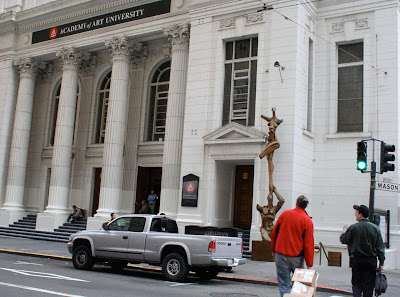 It’s a big school. In the illustration major alone, there are 900 students enrolled in the graduate and undergraduate levels out of a student body of 12,000. Every student and every teacher we met seemed to have a genuine zeal for their work and an affection for each other.
It’s a big school. In the illustration major alone, there are 900 students enrolled in the graduate and undergraduate levels out of a student body of 12,000. Every student and every teacher we met seemed to have a genuine zeal for their work and an affection for each other.
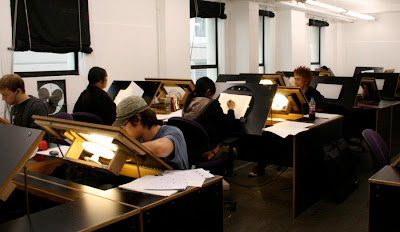 Like the other two west coast schools we visited, (Art Center and SJSU), AAU has responded to the growth of the video game and CGI animation business by building a first-rate course of study for animation, storyboarding, and visual development—or to use the current lingo: “vis dev.”
Like the other two west coast schools we visited, (Art Center and SJSU), AAU has responded to the growth of the video game and CGI animation business by building a first-rate course of study for animation, storyboarding, and visual development—or to use the current lingo: “vis dev.”
This cutting-edge curriculum is founded on traditional knowledge and skill at drawing and sculpting the figure, with an emphasis on story and character.
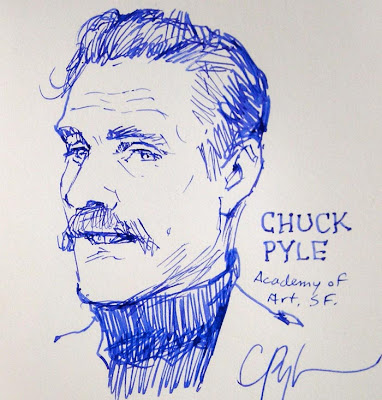 “The ability to think with a pencil is the core of surviving in a 3D world,” illustration director Chuck Pyle told me. “We’re not here to train them for today or tomorrow. We want to give our students the skill set they can use forty years out.”
“The ability to think with a pencil is the core of surviving in a 3D world,” illustration director Chuck Pyle told me. “We’re not here to train them for today or tomorrow. We want to give our students the skill set they can use forty years out.”
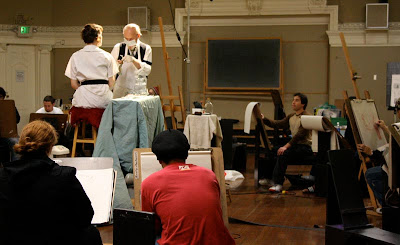 We visited a class that was drawing from the costumed model in a high-ceilinged top-floor ballroom. Students clustered around a pair of models dressed in the theme of a doctor and his patient. They drew what they observed within the 20-minute poses, but also used their imaginations to elaborate the characterizations.
We visited a class that was drawing from the costumed model in a high-ceilinged top-floor ballroom. Students clustered around a pair of models dressed in the theme of a doctor and his patient. They drew what they observed within the 20-minute poses, but also used their imaginations to elaborate the characterizations.
Other themes have included Knights, Witches, and Barbarians. Clothing and costume are a key part of the training, taught by Lisa Berrett and Barbara Bradley, the latter a veteran of the famous Cooper Studios.
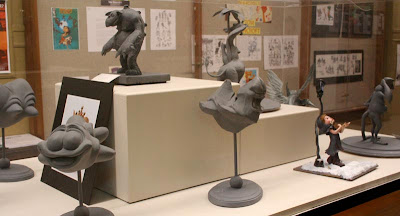 There’s a class in maquette building, with gray clay models (above) of imaginative cartoon characters. We also looked in on a class of traditional drawn animation.
There’s a class in maquette building, with gray clay models (above) of imaginative cartoon characters. We also looked in on a class of traditional drawn animation.
For those of you who are chemically sensitive to oil solvents, you might be interested that AAU has state of the art ventilation and waste disposal technology.
Students can take a sculpture course where they build the figure from the bones outward. Legendary ILM creature designer Terryl Whitlatch teaches animal drawing. Once she brought in live ocelots. European-trained figure drawing master James X. Barbour teaches a whole course in drawing the head and hands.
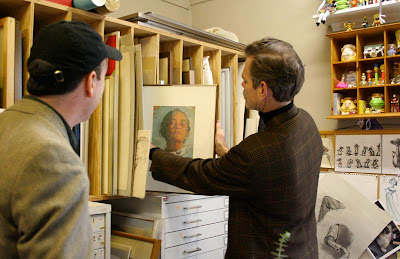 The school is particularly strong in teaching the history of illustration. Instructors can borrow original art from the teaching collection, which includes works by illustrators from the last five decades. Unlike many art schools, where the ability to teach illustration history is controlled and hampered by snobby art history department admistrators, AAU lets Steve Kloepfer, one of America’s foremost experts, teach a whole course on the subject.
The school is particularly strong in teaching the history of illustration. Instructors can borrow original art from the teaching collection, which includes works by illustrators from the last five decades. Unlike many art schools, where the ability to teach illustration history is controlled and hampered by snobby art history department admistrators, AAU lets Steve Kloepfer, one of America’s foremost experts, teach a whole course on the subject.
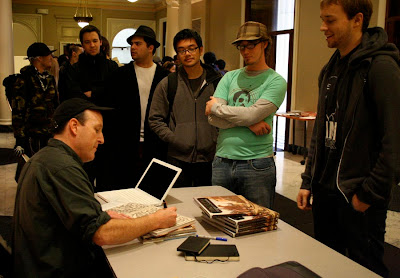 As I signed books after my talk, I had a strong feeling that I will be hearing again from each of the students five years from now, from the point of view of their successful positions inside the industry or out there as published illustrators.
As I signed books after my talk, I had a strong feeling that I will be hearing again from each of the students five years from now, from the point of view of their successful positions inside the industry or out there as published illustrators.
To all my new—and old— friends at AAU, congratulations and best wishes!
At San Jose State University, every student majoring in illustration learns how to animate. The four-year program at this public university just south of the San Francisco Bay includes the traditional practice of creating flat illustrations for print, but it also covers acting, lighting, and creature design skills needed for the burgeoning fields of CGI and interactive.
 Illustration/Animation chairman Alice Carter, herself a well-known illustrator and author, helped design the new curriculum. “Twelve years ago,” she told me, “we saw the business change. Print was gone, and it was being replaced by video games and CGI animation. We stripped down the program to just drawing.” SJSU began teaching how to sculpt maquettes, how to draw backgrounds, and how to develop a narrative with a storyboard.
Illustration/Animation chairman Alice Carter, herself a well-known illustrator and author, helped design the new curriculum. “Twelve years ago,” she told me, “we saw the business change. Print was gone, and it was being replaced by video games and CGI animation. We stripped down the program to just drawing.” SJSU began teaching how to sculpt maquettes, how to draw backgrounds, and how to develop a narrative with a storyboard.
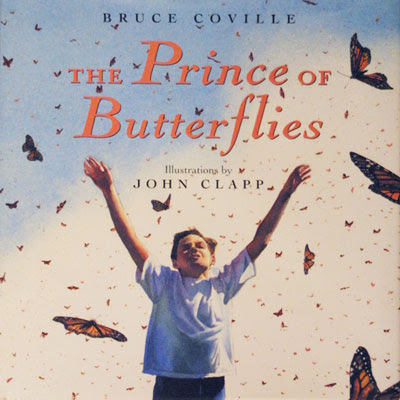 We met John Clapp, (book cover above), one of the professionals from illustration faculty.
We met John Clapp, (book cover above), one of the professionals from illustration faculty.
Alice "Bunny" Carter walked us through the art building and showed us the impressive senior portfolio booklets, each of which looks like an “Art of” production design handbook. “We teach the exact same thing in every class,” she said, “gesture, construction, anatomy, and technique—in that order of importance. Our emphasis is drawing. We teach figure drawing in every class.” Students have a sketchbook assignment to draw fifty trees and fifty windows. They go to the zoo to draw animals from life.
Students also learn computer graphics skills once they’ve got a handle on drawing, but “we don’t give application courses, except for Maya.” Ms. Carter admitted that graduating students don’t have as much time to spend with painting and color as they’d like, but they’ve only got four years.
 There’s no portfolio entrance requirement; everyone is admitted, but midway through their period of study, students have to pass a review. Once they do, the older students give them a t-shirt and welcome them into the “Shrunken Head Club.”
There’s no portfolio entrance requirement; everyone is admitted, but midway through their period of study, students have to pass a review. Once they do, the older students give them a t-shirt and welcome them into the “Shrunken Head Club.”
The big players in the industry, like DreamWorks, EA, and Pixar, have taken notice. We looked into a classroom where students were sharing animation pencil tests via a video link with professionals at Disney. Recruiters regularly pick off the graduates. Almost 100% of them are hired.
Jeffrey Katzenberg of DreamWorks recently announced a six-figure donation to help build the animation program even more. The grant is welcome in a public institution that is a bit strained for resources. Tuition is one of the lowest of the schools we’ve visited. As a result of the tight funds, the computer rooms and cafeteria are crowded.
 I shared my Dinotopia presentation with a group of over 200 students packed into a double classroom. At supper later, Alice said she often hears illustrators back east complaining about the declining field of magazine illustration. But she sees the industry with fresh eyes. “We’re committed to visual development, and now we’re known for it. This is the new golden age of illustration.”
I shared my Dinotopia presentation with a group of over 200 students packed into a double classroom. At supper later, Alice said she often hears illustrators back east complaining about the declining field of magazine illustration. But she sees the industry with fresh eyes. “We’re committed to visual development, and now we’re known for it. This is the new golden age of illustration.”
It's been a flurry of visits to art schools and movie studios over the last two weeks. I'm way behind on the blog!
We started off by giving the presentation at Rhythm & Hues, DreamWorks Animation, LA Public Library, Sony Pictures Animation and Imageworks in southern California.
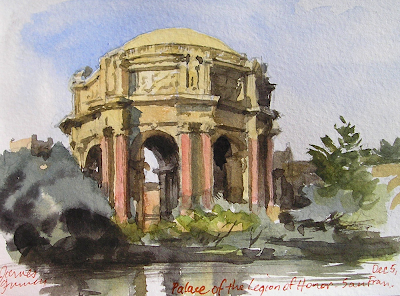 Then in northern California we've had the privilege of visiting PDI DreamWorks and Academy of Art University. Today we went to Industrial Light and Magic in the Presidio region of San Francisco. We arrived early with an hour to kill, so we both did watercolor sketches of the Palace of Fine Arts, a remnant of the 1915 Pan-Pacific Exposition.
Then in northern California we've had the privilege of visiting PDI DreamWorks and Academy of Art University. Today we went to Industrial Light and Magic in the Presidio region of San Francisco. We arrived early with an hour to kill, so we both did watercolor sketches of the Palace of Fine Arts, a remnant of the 1915 Pan-Pacific Exposition.
 Then we entered the ILM complex. We blithely passed beyond guards, gates, cameras, flashing red lights, magnetic barriers, and a gurgling fountain surmounted by a bronze Yoda. I felt a little like Luke entering the Death Star. We set up the laptop in a cavernous state-of-the-art theater, and soon artists started arriving for the talk.
Then we entered the ILM complex. We blithely passed beyond guards, gates, cameras, flashing red lights, magnetic barriers, and a gurgling fountain surmounted by a bronze Yoda. I felt a little like Luke entering the Death Star. We set up the laptop in a cavernous state-of-the-art theater, and soon artists started arriving for the talk.
It was an honor to meet so many ILM legends, like Erik Tiemens, Carlos Huante, Darin Hilton, and many more whose work I greatly admire. Thanks to our host Josh Kushins (below with our folding hand truck), and to everyone who attended. And for those of you blog readers who are art students, ILM is an amazing place to work, justly famous for its Oscar-winning legacy, its spirit of innovation, its vast talent pool of about 1200 professionals, and its spectacular location.
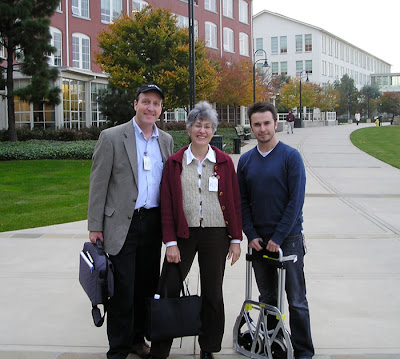 And I haven't even mentioned the bookstores: Storyopolis, Linden Tree, Booksmith, and Cody's, where I got to meet Austin Madison from Pixar.
And I haven't even mentioned the bookstores: Storyopolis, Linden Tree, Booksmith, and Cody's, where I got to meet Austin Madison from Pixar.
The full report on all the other studios and schools will have to wait a while until we catch up. Tomorrow: San Jose State!
On the way up Highway 101 yesterday, we decided on a whim to try and visit Ted Youngkin, our favorite art teacher, who taught us everything we know about perspective (and a lot more that we’ve forgotten). I think of him every time I do a drawing.
 Jeanette and I met in Mr. Youngkin's class 27 years ago. He was tough and scary back then, only because he demanded so much from us, and wouldn't stand for anything less than our best. He has been retired from teaching for a long time now. We have exchanged many letters and photos over the years, and I know that beneath that scariness is a real love for his students, based on a desire to see them do well.
Jeanette and I met in Mr. Youngkin's class 27 years ago. He was tough and scary back then, only because he demanded so much from us, and wouldn't stand for anything less than our best. He has been retired from teaching for a long time now. We have exchanged many letters and photos over the years, and I know that beneath that scariness is a real love for his students, based on a desire to see them do well.
It wasn’t easy to find him. I have never had his phone number, and he’s not listed. He has no email or website. No one at Art Center seemed to be in touch with him anymore. I had his address on a scrap of paper, and a guy in a gas station in Solvang found the street on a tattered map. When we got there, it was a gated community.
 I rang the house from the gate, and amazingly he answered. At first he thought someone was pranking him. A minute later he met us in his driveway and I handed him a copy of the new book.
I rang the house from the gate, and amazingly he answered. At first he thought someone was pranking him. A minute later he met us in his driveway and I handed him a copy of the new book.
 He and Martha graciously invited us in. Incredibly, he is still working every day, creating complex drawings of architectural facades in Pilot pen and marker, based on his travels all around the world. He has recent sketchbooks full of drawings, not just of architecture, but also of people.
He and Martha graciously invited us in. Incredibly, he is still working every day, creating complex drawings of architectural facades in Pilot pen and marker, based on his travels all around the world. He has recent sketchbooks full of drawings, not just of architecture, but also of people.
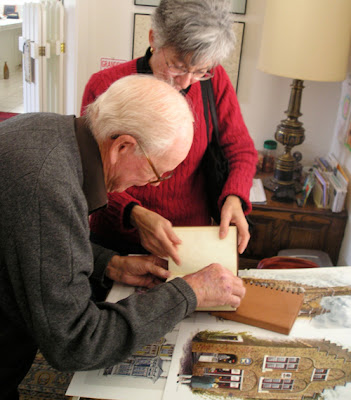
He asked to see Jeanette’s sketches, and looked through her sketchbook page by page. An hour went by in a moment, but we had to go.
As we drove on north on the coast highway, Jeanette said something that really struck me, and I think she’s exactly right: “Perspective is the basis for all drawings, even figure drawings.”
I must admit that I was apprehensive about my visit to Art Center College of Design in Pasadena, California. It has been over 25 years since I was a student there (I was only able to stay for two semesters), and I wondered how it had changed.
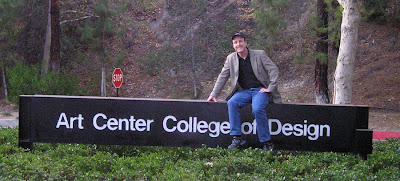 In the early 1980s the Art Center illustration program was focused primarily on modern-art inspired “concept” illustration. Students were groomed for painting trendy magazine illustrations and album covers. The emphasis was on style. There was no encouragement for careers in paperback covers, children’s books, wildlife art, comic art, animation, movie production design or landscape painting. A few teachers demonstrated the skills of traditional realism, but they were in the minority, and some of the best of them ended up leaving to teach elsewhere.
In the early 1980s the Art Center illustration program was focused primarily on modern-art inspired “concept” illustration. Students were groomed for painting trendy magazine illustrations and album covers. The emphasis was on style. There was no encouragement for careers in paperback covers, children’s books, wildlife art, comic art, animation, movie production design or landscape painting. A few teachers demonstrated the skills of traditional realism, but they were in the minority, and some of the best of them ended up leaving to teach elsewhere.
Art Center is a different school now, and the changes are all for the better. The school is housed in a long black building set in the hills above Pasadena. But gone is the minimal, sterile look of the 1980s. Glass cases filled with student work now cover walls that once were blank. One display held a group of beautifully-observed paintings made in Gary Meyer’s class based on a live model wearing an interesting clown outfit.
 Bob Kato is one of the new generation of teachers. He was taught by Dennis Nolan (the Hartford teacher). Himself a master draftsman and painter, Mr. Kato leads his students to a high level of proficiency. During the fourteen week term of his Sketching for Illustration class, he starts with line and value, follows with a model lit from a single light source, and ends with costumed models lit from multiple colored light sources. Bob Kato also hosts extracurricular sessions called The Drawing Club.
Bob Kato is one of the new generation of teachers. He was taught by Dennis Nolan (the Hartford teacher). Himself a master draftsman and painter, Mr. Kato leads his students to a high level of proficiency. During the fourteen week term of his Sketching for Illustration class, he starts with line and value, follows with a model lit from a single light source, and ends with costumed models lit from multiple colored light sources. Bob Kato also hosts extracurricular sessions called The Drawing Club.
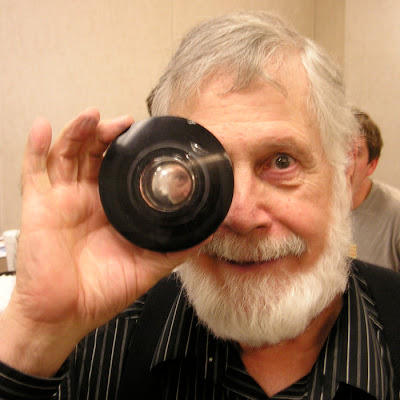 We visited Gary Meyer’s perspective class, where he was discussing fisheye distortion. Because of its industrial design component, perspective has always been a strength of the school, and Mr. Meyer is ably following in the very large footsteps of Ted Youngkin, now retired, who taught the likes of Syd Mead.
We visited Gary Meyer’s perspective class, where he was discussing fisheye distortion. Because of its industrial design component, perspective has always been a strength of the school, and Mr. Meyer is ably following in the very large footsteps of Ted Youngkin, now retired, who taught the likes of Syd Mead.
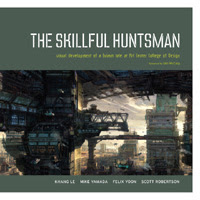 Much of the buzz about Art Center now revolves around its new entertainment design department, headed by Scott Robertson. His students were responsible for the recent book Skillful Huntsman, an exercise in production design that holds its own in print with publications by working professionals. Combining industrial design with illustration, students in this new major learn the skills they’ll need for visual development careers at the nearby movie studios, with classes often taught by instructors from DreamWorks, Disney, and Imageworks.
Much of the buzz about Art Center now revolves around its new entertainment design department, headed by Scott Robertson. His students were responsible for the recent book Skillful Huntsman, an exercise in production design that holds its own in print with publications by working professionals. Combining industrial design with illustration, students in this new major learn the skills they’ll need for visual development careers at the nearby movie studios, with classes often taught by instructors from DreamWorks, Disney, and Imageworks.
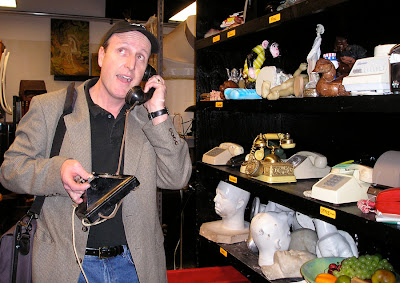 The school now has a prop room, filled with costumes, mannikins, musical instruments, and everyday objects to use for staging an illustration. Students can check them out to take home, or models can pose with them in school.
The school now has a prop room, filled with costumes, mannikins, musical instruments, and everyday objects to use for staging an illustration. Students can check them out to take home, or models can pose with them in school.
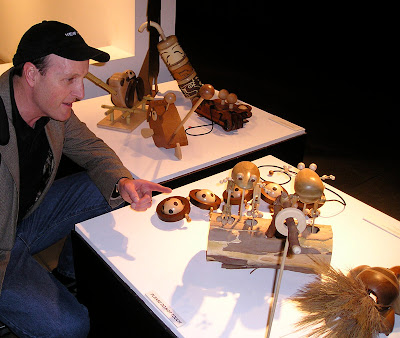 Every Art Center student learns how to use woodshop tools. Here’s a display of working pull toys.
Every Art Center student learns how to use woodshop tools. Here’s a display of working pull toys.
Illustration chair Ann Field typifies the exciting new spirit of the school, keeping right up with the times, but respecting timeless tradition. She told me that she respects the school’s duty to provide a strong foundation in traditional drawing and painting skills that can outfit a graduate for success in any career direction. “Some things will forever be true,” she told me. No matter how art and styles change, “you will always need to know how to paint and draw.”
Syracuse University's art school has a long reputation for training artists and illustrators. Two of my heroes, Tom Lovell and Harry Anderson, graduated from Syracuse around 1930.
 The campus adjoins the city of Syracuse in the center of New York State. Its hilly location gives its students lots of exercise as they travel from class to class.
The campus adjoins the city of Syracuse in the center of New York State. Its hilly location gives its students lots of exercise as they travel from class to class.
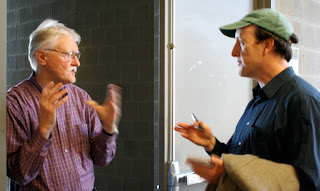 John Thompson heads the illustration program. His approach is traditional and realistic. We sat in on a class as he introduced an assignment on the theme of “inside and outside” He showed slides of compositional framing devices ranging from Titian to Bernie Fuchs.
John Thompson heads the illustration program. His approach is traditional and realistic. We sat in on a class as he introduced an assignment on the theme of “inside and outside” He showed slides of compositional framing devices ranging from Titian to Bernie Fuchs.
He will lead a group of students to India this winter for a sketching tour. He told me that he was in no hurry for students to learn digital tools. At the undergraduate level, the focus is primarily on drawing and painting.
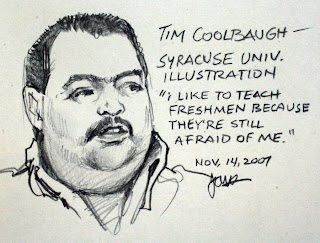 Our guide Tim Coolbaugh took us throughout the rest of the art building, a modern concrete structure at the edge of the quad. Lining the hallways were huge self-portraits showing faces contorted with laughter.
Our guide Tim Coolbaugh took us throughout the rest of the art building, a modern concrete structure at the edge of the quad. Lining the hallways were huge self-portraits showing faces contorted with laughter.
The walls upstairs displayed the results of a line drawing exercise taught by James Ransome, where students used markers to draw interior scenes with figures. They used white artist's tape to erase parts of the drawings as they reconsidered their lines and explored abstract shapes.
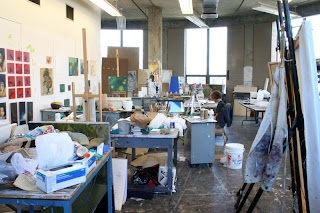 Seniors occupied the tower rooms of the art building, which they customized with their supplies and works-in-progress.
Seniors occupied the tower rooms of the art building, which they customized with their supplies and works-in-progress.
Syracuse University also maintains the Special Collections Research Center, which has an impressive collection of artist’s papers and manuscripts, including cartoonist Roy Crane’s remarkable instructional scrapbook, assembled to guide his assistants in composition.
 After my presentation, I met several of the illustration instructors including, from left to right: London Ladd, Bob Dacey, and James Ransome, and Roger DeMuth (not in picture) all award-winning professional illustrators balancing their own artwork with their teaching.
After my presentation, I met several of the illustration instructors including, from left to right: London Ladd, Bob Dacey, and James Ransome, and Roger DeMuth (not in picture) all award-winning professional illustrators balancing their own artwork with their teaching.
Thanks and best wishes to all at SU!
Most people think of RIT as a technical school for engineers and scientists. But it also has an impressive art and illustration program, which offers its students a skills-oriented course of study in a professional setting.
 The campus consists of rectilinear red brick buildings arranged on a large campus on the outskirts of the city. We arrived at the gallery of the art building, which was hosting an exhibition investigating the design of pop-up books. Each of the basic design principles of pop-ups was illustrated with a giant-sized corrugated plastic model that you could try out.
The campus consists of rectilinear red brick buildings arranged on a large campus on the outskirts of the city. We arrived at the gallery of the art building, which was hosting an exhibition investigating the design of pop-up books. Each of the basic design principles of pop-ups was illustrated with a giant-sized corrugated plastic model that you could try out.
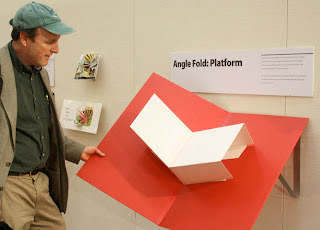 Illustration chairman Bob Dorsey toured us through the art building. He told us that illustration students concentrate on basic skills of drawing and painting for the first two years. When they begin using digital tools later in the program, the college insists on staying on the cutting edge, completely gutting and replacing the computer equipment with the latest technology every two and a half years.
Illustration chairman Bob Dorsey toured us through the art building. He told us that illustration students concentrate on basic skills of drawing and painting for the first two years. When they begin using digital tools later in the program, the college insists on staying on the cutting edge, completely gutting and replacing the computer equipment with the latest technology every two and a half years.
 RIT is one of only two institutions in America that offers comprehensive degree programs in medical illustration (the other is in Cleveland). Department Chairman Glen Hintz showed us tearsheets of alumni (above), and the room where students get artistic training in the area of human anatomy and physiology.
RIT is one of only two institutions in America that offers comprehensive degree programs in medical illustration (the other is in Cleveland). Department Chairman Glen Hintz showed us tearsheets of alumni (above), and the room where students get artistic training in the area of human anatomy and physiology.
 The medical illustration program is closely integrated with the university’s biology department, and students have full access to cadavers and head-to-toe dissection.
The medical illustration program is closely integrated with the university’s biology department, and students have full access to cadavers and head-to-toe dissection.
To my knowledge, no school that I've seen yet offers a course specifically in animal anatomy for the artist—but I believe every art school should! If you know of such a school, shout it out on the comments.
RIT is also the home for the legendary School for American Crafts. For students interested in woodworking, metalworking, glassblowing, or ceramics (textiles were discontinued in the mid-90s), there is probably no better place to learn from modern masters. Illustration majors are able to sample from these resources as electives.
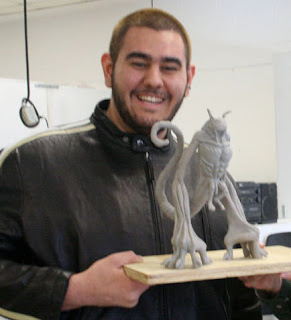 There are also programs in animation and sculpture or "dimensional" work. Here is a dimensional major named Matt, with his sculpture called the “Key Keeper,” an alien creature who walks on his fingers and holds his keys with his tail.
There are also programs in animation and sculpture or "dimensional" work. Here is a dimensional major named Matt, with his sculpture called the “Key Keeper,” an alien creature who walks on his fingers and holds his keys with his tail.
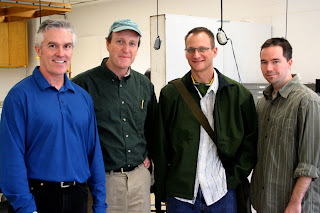 After my presentation on Dinotopia, I enjoyed talking with Bob Dorsey and the other members of the illustration faculty. These teachers obviously have great sympathy and respect for each other and a profound regard for their students. We’ve noticed that when all the teachers get along as friendly colleagues, the students benefit from the chemistry and the unity of vision, and they do their best work.
After my presentation on Dinotopia, I enjoyed talking with Bob Dorsey and the other members of the illustration faculty. These teachers obviously have great sympathy and respect for each other and a profound regard for their students. We’ve noticed that when all the teachers get along as friendly colleagues, the students benefit from the chemistry and the unity of vision, and they do their best work.
Thanks again and best wishes to everyone at RIT, and I wish I had had more time to visit with you!
The art school at the State University of New York in Fredonia is an undiscovered gem.
The campus adjoins a tree-shaded small town in the rolling farmland of southwestern New York State. Jeanette and I spent the morning painting watercolors on a nearby Amish farm, accompanied by the sounds of a creaky windmill and a horse-drawn manure-spreader.
 Fredonia has a fully restored 1891 opera house where the college’s animation majors can screen their capstone film projects. The school recently expanded its illustration program to include animation, under the leadership of the new illustration/animation chair Jill Johnston-Price.
Fredonia has a fully restored 1891 opera house where the college’s animation majors can screen their capstone film projects. The school recently expanded its illustration program to include animation, under the leadership of the new illustration/animation chair Jill Johnston-Price.
Because of her expertise, most of the illustration majors develop a love and awareness for the moving image, all of them beginning the traditional way with a pencil and a light table or with stop motion before moving into digital tools.
 Dr. Alberto Rey, who heads up the drawing and painting major, was born in Cuba. A gifted watercolor painter and fly fisher, he brings his painting students outdoors to work directly from life. A row of French easels is available for anyone to borrow for their landscape painting exercises.
Dr. Alberto Rey, who heads up the drawing and painting major, was born in Cuba. A gifted watercolor painter and fly fisher, he brings his painting students outdoors to work directly from life. A row of French easels is available for anyone to borrow for their landscape painting exercises.
“We try to get the students out of the sterile environment,” he said. “When they go outside, they have to learn to compose. Otherwise they get too structured and too dependent on photography.”
 The focus of the curriculum is on fundamental hands-on skills. Drawing and painting students get the chance to hand-sculpt a figure in clay to deepen their understanding of the form of the figure.
The focus of the curriculum is on fundamental hands-on skills. Drawing and painting students get the chance to hand-sculpt a figure in clay to deepen their understanding of the form of the figure.
 There’s a room set up for intaglio printing and stone lithography, as well as a whole workshop for welding.
There’s a room set up for intaglio printing and stone lithography, as well as a whole workshop for welding.
One of the assignments involved drawing a life-size self portrait nude in charcoal, which meant scaling up a drawing in the traditional way and very carefully modeling the tones. All the painting students learn how to make their own stretcher bars in the woodshop and stretch and prepare their own canvases.
But Dr. Rey believes that the thinking is equally vital. “It’s important that the students develop intellectually and conceptually,” he said, and part of the work of the painting majors involves writing their own artist statements.
One of the strengths of the art school at Fredonia, apart from its reasonable tuition costs, is the fact that it is part of a larger university, rated twelfth overall in the US News ranking for public institutions in the north. The college is strong in early education, music, performance, and public health. We met one art student who is combining her love of art with nursing and anthropology, with the goal of working in the field of art therapy. Another double-major that we met wants to go into teaching art to schoolchildren.
 “It’s exciting conceptually for an instructor to work with the students,” said Dr. Rey. “The students are all different.” As different and unique as clay pots, I thought to myself as I surveyed a display of hand-thrown ceramics laid out on a counter overlooking a stand of maples in their full autumn finery. Such passion for teaching helps direct and fire the destiny of each of these young artists as surely as the potter shapes the clay.
“It’s exciting conceptually for an instructor to work with the students,” said Dr. Rey. “The students are all different.” As different and unique as clay pots, I thought to myself as I surveyed a display of hand-thrown ceramics laid out on a counter overlooking a stand of maples in their full autumn finery. Such passion for teaching helps direct and fire the destiny of each of these young artists as surely as the potter shapes the clay.
RISD student Kelly Berg said that one of the favorite parts of her job as monitor in the Nature Lab of Rhode Island School of Design in Providence, Rhode Island is handling the Madagascar hissing cockroaches. “The make great pets,” she told me. "They hiss a bit, but they’re quite friendly."
The lab’s collection gives art students access to living animal specimens to use as models. Besides the giant cockroaches, there are millipedes, rhinoceros chameleons, rats, frogs and turtles.
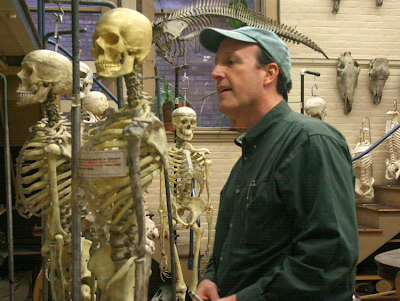 There’s also a large variety of animal skulls and skeletons. One room adjoining the nature lab collection had half a dozen human skeletons with drawing easels set up beside them.
There’s also a large variety of animal skulls and skeletons. One room adjoining the nature lab collection had half a dozen human skeletons with drawing easels set up beside them.
 Along the walls were cabinets crammed full of shells, seedpods, and crystals.
Along the walls were cabinets crammed full of shells, seedpods, and crystals.

This student from nearby Brown University, one of the Ivy League colleges, was doing a careful pencil drawing of a stuffed squirrel. Brown students can share in RISD’s art offerings. In exchange, RISD students can broaden their education by enrolling in Brown’s first-rate courses in academic subjects to supplement the focused art curriculum.
RISD students also have access to the collection of the RISD art museum, whose collection ranks with some of the finest small museum collections of the northeast.

Illustration chairman Nick Jainschigg (above) toured me through the building which houses classes for the approximately 250 illustration majors. The school has graduated some notable illustrators like Chris Van Allsburg and has attracted some current high-profile teaching talent, including Jon Foster. Classes keep current with emerging trends, and include offerings in graphic novels, 3-D character animation, and video game design.
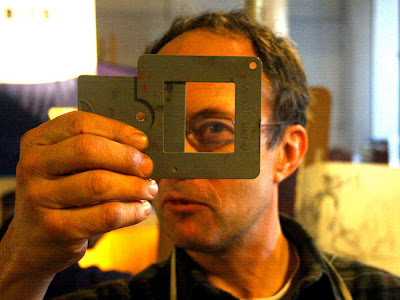
We met painting instructor Nick Palermo, here demonstrating a “View Catcher” device, which helps new painting students frame a composition. Palermo’s class was working on oil studies of a model posing on a stand with colorful props and upshot lighting.
Part of what makes RISD’s program unique is the winter session, sandwiched between the regular semesters. The six week winter session is both informal and intensive, allowing students to try out something outside their normal experience, like stone lithography or glassblowing.
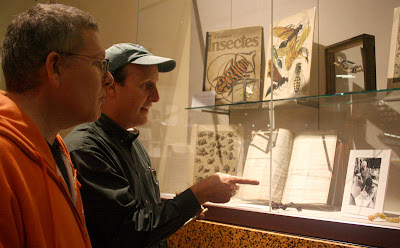
The Fleet Library in the newly refurbished bank building contains not only a rich collection of art books dating back to the 1860s, but also a vast array of scrapbooks, sketchbooks, design collections, clippings, art prints and ephemera.
More than one person admitted that not enough RISD students take advantage of the school’s rich resources, and that the requirement to use them is not woven enough into the curriculum. But for a motivated student, RISD certainly has a lot to offer.
It’s only a small step from the sophomore still life painting class, with its enticing linseed-oil aroma, to a balcony overlooking a palmetto-lined bayou, where manatees swim by from time to time. The Ringling College of Art and Design occupies a diverse group of Spanish-style buildings on its 35 acre campus in Sarasota, along the Gulf Coast of Florida. The school is still growing, actively acquiring new land, new degree programs and new students.
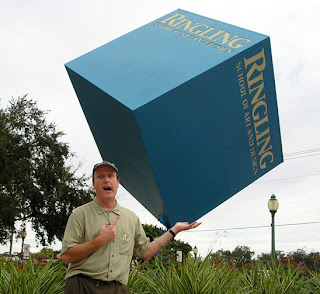
“We’re about destroying the myth of the starving artist,” college president Dr. Larry Thompson told me. Alumni polled a few years after graduation revealed that ninety percent were working in their field of interest. The school gives each student a fully loaded PowerMac Pro as they enter. According to Dr. Johnson, the two-to-one student to computer ratio rivals some of the top engineering schools. “Ringling is the MIT of colleges of art and design,” he said, reeling off a list of companies—Pixar, Lucasfilm, Dreamworks, American Greetings, and Electronic Arts—whose recruiters regularly lure away graduates.

Ringling offers a comprehensive program in computer animation and interactive game design, the latter using the latest CryENGINE 2 software tools. The new five-storey Ulla Searing Center is lined with framed posters from movies that Ringling graduates have worked on. Seniors in the animation department were hard at work in air-conditioned computer rooms refining their long-range assignments, which includes storyboarding, designing, sculpting, rigging, animating, and lighting their own short films.

But the school is not all high tech and corporate. Old-fashioned animation tables donated by the defunct Disney animation studios are still in use for teaching the traditional methods. The library has a huge collection of art books. I was impressed that when one of the librarians in Ringling’s library saw the listing of recommended art instruction books on this blog she got right to work tracking them down.

Department chairman Tom Casmer, himself an accomplished children’s book illustrator, supervises 400 students in the illustration major, almost a third of the 1200 member student body. “We focus on the basics of painting, drawing, and thinking,” he said. “We push drawing for the first two years of study.” At heart, he said, illustrators are storytellers, and “the narrative aspect permeates all majors.” He wants illustration majors to be “scholar-practitioners.” Art can’t just be an end in itself. It has to be founded on primary research, timeless ideas and clear communication.
I met the students one by one as I signed books for two and a half hours after my Dinotopia presentation and was struck with their friendliness, their intense focus and their enthusiasm for art. Most of them were carrying sketchbooks and doodling in them. Illustration senior Andrew Wright regularly paints en plein air with a group of his classmates and with teacher George Pratt.
 Jeanette and I regretted having to take off so soon for the long nighttime drive across the state, because we knew we’d have to miss the opportunity to join the Ringling students for a painting session. But we were happy to think of all of our new friends working so hard in such a beautiful environment, with such bright prospects before them.
Jeanette and I regretted having to take off so soon for the long nighttime drive across the state, because we knew we’d have to miss the opportunity to join the Ringling students for a painting session. But we were happy to think of all of our new friends working so hard in such a beautiful environment, with such bright prospects before them.
Yesterday I presented my digital slide show to the Hartford Art School in Connecticut. I had visited the school 18 years ago, and have heard great things about it since. Hartford has been delivering a steady stream of winners to the Society of Illustrators student competitions.
The training program in the illustration department is founded on traditional skills, close observation, and mastery of media. It’s one of the few schools that offers a class in watercolor painting, taught by Dennis Nolan (see post on Art History: A Fresh View from a week ago). Dennis has illustrated many children’s books, including the award-winning Dinosaur Dream.

The other illustration teachers are Doug Anderson, who honed his professional skills as a science fiction cover artist and a space technology illustrator for Lockheed; and Bill Thomson, below, who gave up a lucrative career in advertising illustration because of his love of teaching.

These three musketeers are close friends, and in close sympathy with each others' teaching philosophies. Their classes cover human and animal anatomy, perspective, illustration history, composition, and figure drawing.
Student work in the gallery was at a uniformly high level and emphasized controlled technique combined with a sense of humor. There were self-portraits with funny hats using a Rapidograph stipple technique, and faces made from vegetables a la Arcimboldo. Some of the students told me that they had trouble with rotting eggplants during the two weeks' rendering time.
Seniors were working on zoo posters to refine their skills in animal drawing and graphic communication.
There was excitement at our lunch table, because painting professor Jeremiah Patterson had, just minutes before, received approval to team-teach with a science professor a course about the science of art, including optics, color theory, and paint chemistry.
Man, I wish there was a course like that when I was in art school!





















Can't wait to get my hands on it, Mo!! Congratulations!!